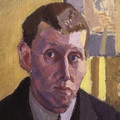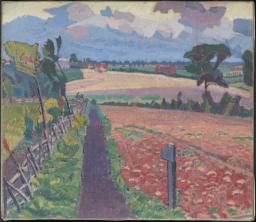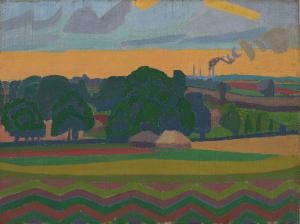Spencer Gore, ‘Cézanne, Gauguin, Van Gogh &c., at the Grafton Galleries’
The Art News, 15 December 1910, pp.19–20.
Cézanne, Gauguin, Van Gogh &c., at the Grafton Galleries.
A criticism of this exhibition presents some difficulty. The paintings have been so ill received that one feels more ready to pour a stream of violent abuse on the heads of the critics and public than attempt a piece of more or less intelligent criticism. Cézanne, Gauguin, Van Gogh, Seurat, and Signac have their accepted places on the Continent, just as Joseph Israels, Mauve, and the brothers Maris have in England. France has as much right to have its Matisse, Piccasso, Marquet, Denis, and other painters with various aims, as England its Steer, Ricketts, Shannon, John, Orpen, &c.
If there was an exhibition in Paris of Rossetti and Burne Jones might not the French critic point out that none but madmen could have produced such curious creatures, such quaint angularities, such boneless monstrosities? I only suggest how it might strike him, and how wrong he would be!
There seems very little need for the inclusion of Manet in this exhibition. Cézanne and Gauguin have very little connexion with him, and there is probably no other painter represented here who would admit any at all. Besides, as M. Blanche points out in his letter to The Morning Post – a letter that must have appealed to every Englishman, fearful that he might entrust his daughter’s portrait to some budding Van Gogh – the Manets are inferior Manets. Perhaps it is only this which accounts for the poor show they make beside the Cézanne’s.
Cézanne was a painter who sought above everything else an exact harmony of colour, as exact as Whistler’s relations of tone. In attaining this he often lost the drawing, which he would then recover with a line. Hence incompleteness. The incompleteness not of the shirker, but of the man who has pursued a thing as far as he can go, and still finds the end just out of reach. And it is the intense sincerity with which he pursues his object which gives to his painting that wonderful gravity, and makes such paintings as Manet’s ‘Bar at the Folies-Bergère’ or ‘The Café’ appear, as they really are, pictures “faked” in the studio by the virtuoso of great skill, but without any particular object.
Of all the painters represented here Gauguin seems to be the least disliked. He is certainly the best represented. Those interested in lineage might find amusement in tracing the influence of Camille Pissarro, not only in the Breton pictures, but also in the Tahitan.
The attempt to separate the decorative side of painting from the naturalistic seems to me to be a mistake. Durer [sic] is supposed to have said just before he died, that he had begun to see how simple nature was. Simplification of nature necessitates an exact knowledge of the complications of the forms simplified. This may be done to produce a greater truth to nature as well as for decorative effect. I should like to know, for instance, into which category any one is going to put ‘Martinique’ (34), or ‘Les Laveuses’ (83), or ‘Paysage Bretonne’ (87).
Every picture has its origin, in something seen either at first hand in nature or second hand in some other picture – something that has filtered through one brain, through the brains of a generation, or many generations. Gauguin gives his idea of Tahiti just as Goya gave his of Spain. It is equally untrue to say of Pissarro, Sisly [sic], Signac, or Seurat that they cared for nothing except the momentary effects of light on objects as it is to say of Cézanne or Gauguin that they simplified objects to express the emotional significance which lies in things. All of them were equally interested in the character of the thing painted, and if the emotional significance which lies in things can be expressed in painting the way to it must lie through the outward character of the object painted.
Again Cézanne’s and Gauguin’s method was just as subtle and complicated as the methods of the others. Cézanne differed in using various tints of the same colour instead of the broken colour used by the others in a greater or lesser degree as it suited their purpose at different times, Seurat and Signac, of course, carrying the broken colour method to its furthest point.
Signac more than either Gauguin or Cézanne simplified nature, reducing it to a series of silhouettes filled with colour. A future generation, forgetting their quarrels, forgetting the [end of p.19] names they were given, and the names they gave themselves, will certainly find them much more closely linked together than we are able to. It is possible to imagine them seated at a round table. Gauguin between Degas and Pissarro, Cézanne, Van Gogh, Seurat, Signac, Moret, and so on round to Manet, Renoir, and Degas again.
Of the present-day division of the exhibition it is not possible to say very much, none of them being very well represented. Piccasso [sic], and Matisse have nothing there of any great interest, or that gives any clue to their work as a whole. Frietz’s Balcony, with the river behind, is extremely interesting. Marquet (108–114) Serusier (93, 95, and 96) and Puy (147) are artists of whom we would like to see more. Such painting as Herbin’s ‘Maison au Quai vert’ (108) arouses our curiosity, as also do the paintings of Deraud. Let us hope next time for an entirely modern and representative exhibition of French painting.
S.F.G.
How to cite
Spencer Gore, ‘Cézanne, Gauguin, Van Gogh &c., at the Grafton Galleries’, in The Art News, 15 December 1910, pp.19–20, in Helena Bonett, Ysanne Holt, Jennifer Mundy (eds.), The Camden Town Group in Context, Tate Research Publication, May 2012, https://www



